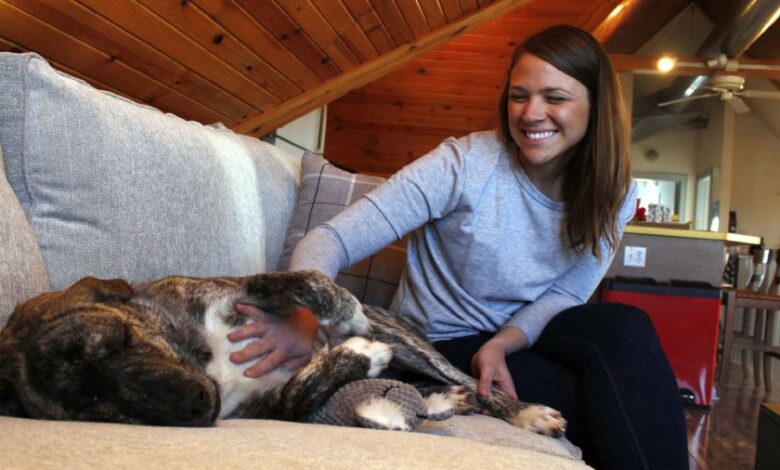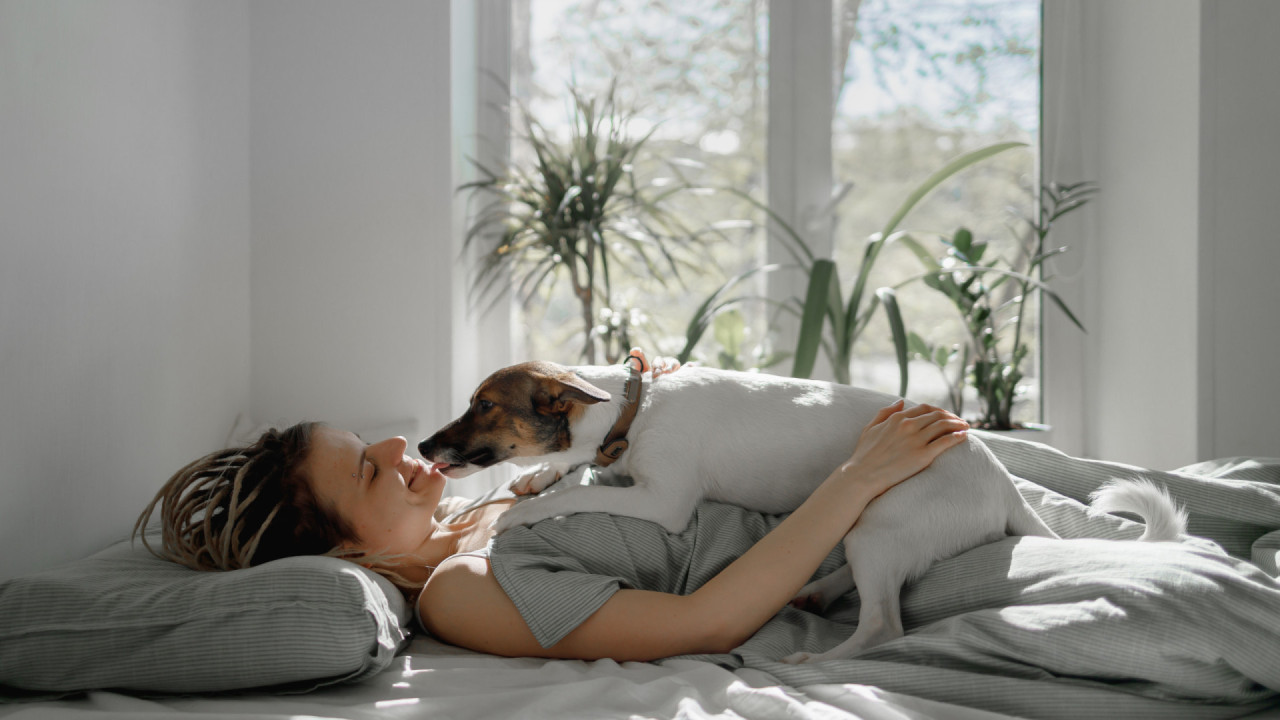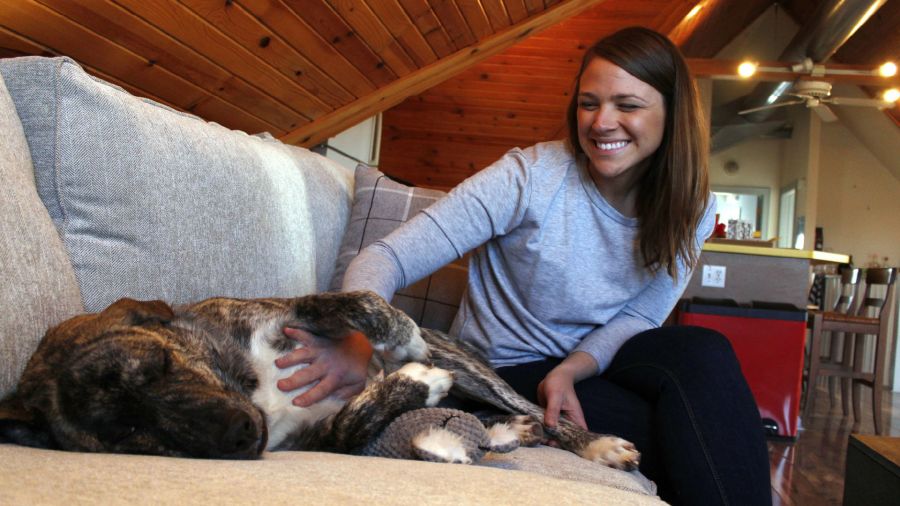
Why women sleep better with dogs? This exploration delves into the fascinating connection between canine companionship and improved sleep quality in women. From the physiological impact of oxytocin to the psychological comfort a dog provides, we’ll uncover the surprising ways our furry friends can enhance our slumber.
This in-depth look examines potential physiological, psychological, practical, social, and cultural factors influencing sleep quality when women share their beds with dogs. We’ll explore the impact of dog breeds, sleep hygiene, and even cultural norms to understand this unique relationship.
Potential Physiological Factors
The presence of a dog in a woman’s bedroom can significantly influence her sleep quality, impacting both physical and emotional well-being. Beyond the comfort and companionship, several physiological factors contribute to this positive correlation. Understanding these mechanisms sheds light on the profound impact of canine companionship on sleep.The comforting presence of a furry friend can trigger a cascade of physiological responses that promote relaxation and a better sleep experience.
This is particularly relevant for women, given the potential influence of hormonal fluctuations on sleep patterns.
Hormonal Impacts of Canine Companionship
The presence of a dog can stimulate the release of oxytocin, a hormone often associated with bonding, trust, and relaxation. This release can contribute to a sense of calm and security, lowering stress hormones like cortisol. This, in turn, can facilitate a more peaceful transition into sleep. Furthermore, consistent interaction with a dog may lead to a more stable hormonal balance, promoting better sleep quality over time.
Studies have shown that oxytocin levels increase in response to physical touch, such as petting a dog, leading to a more relaxed state conducive to sleep.
Neurological Influence on Sleep Patterns
The neurological effects of canine companionship extend beyond the hormonal response. The act of petting or interacting with a dog can trigger the release of endorphins, which have mood-boosting effects. A positive emotional state, achieved through this interaction, is often associated with improved sleep quality. The predictability and regularity of a dog’s presence can also contribute to a more stable sleep-wake cycle, helping to regulate the body’s natural sleep-wake rhythm.
This predictability can be crucial in managing potential sleep disruptions linked to hormonal changes.
Physiological Differences in Sleep Quality
Women who sleep with dogs may experience different sleep quality parameters compared to those who do not. Potential differences could include reduced sleep latency (the time it takes to fall asleep), improved sleep efficiency (the proportion of time spent asleep during the sleep period), and an increase in the duration of deep sleep. However, further research is needed to establish definitive links between these differences and canine companionship.
Anecdotal evidence suggests a general improvement in sleep quality, but scientific studies are still exploring this phenomenon.
Impact of Physical Touch and Warmth
The physical touch and warmth emanating from a dog can induce a sense of comfort and security, promoting relaxation. This physical contact can lower stress levels, potentially contributing to a better sleep environment. The simple act of stroking a dog’s fur can trigger a calming response, promoting relaxation and facilitating sleep onset. The warmth of a dog can also provide a sense of physical closeness, which is often associated with feelings of security and reduced anxiety.
Influence on Heart Rate Variability and Blood Pressure
The presence of a dog may influence heart rate variability (HRV) and blood pressure, impacting sleep quality. A dog’s presence can lead to a decrease in both heart rate and blood pressure before and during sleep. This physiological response, often associated with a relaxation response, can contribute to a more peaceful and restorative sleep. The lower heart rate and blood pressure can lead to a more stable and efficient sleep cycle.
However, further research is needed to quantify the exact impact on HRV and blood pressure in the presence of a dog during sleep.
Psychological Benefits: Why Women Sleep Better With Dogs

Having a furry friend in the bedroom can offer a wealth of psychological benefits for women, impacting sleep quality in profound ways. Beyond the physiological aspects, the emotional and mental well-being derived from canine companionship plays a significant role in a woman’s overall sleep experience. The unconditional love and presence of a dog can create a sense of security and reduce anxiety, which, in turn, can contribute to a more restful night’s sleep.The comforting presence of a dog can be especially beneficial for women experiencing anxiety or stress.
Studies have shown that the interaction with animals can lower cortisol levels, the hormone associated with stress. This reduction in stress hormones can translate into a more relaxed state, facilitating better sleep. For women without pre-existing anxiety, the calming effect of a dog can still contribute to a more peaceful and secure sleep environment.
Impact on Women with Anxiety or Stress
Women who experience anxiety or stress often find it challenging to achieve restful sleep. The presence of a dog in the bedroom can be a powerful tool in mitigating these challenges. A dog’s consistent presence and gentle nature can provide a sense of security and stability, reducing feelings of fear and worry. This, in turn, can lead to a more relaxed state of mind, making it easier to fall asleep and stay asleep.
The predictability of a dog’s routine and the simple act of petting a dog can be a grounding experience, helping to calm racing thoughts and anxieties.
Impact on Women without Anxiety or Stress
Even for women without significant pre-existing anxiety or stress, a dog’s presence can still enhance sleep quality. The simple act of cuddling with a dog, or having a dog’s comforting presence during the night, can foster a sense of security and well-being. The companionship and unconditional love offered by a dog can contribute to a more positive emotional state, which can indirectly influence sleep quality.
The rhythmic breathing of a dog can also create a calming atmosphere, helping to quiet the mind and promote relaxation.
Psychological Mechanisms
The psychological mechanisms through which a dog’s presence improves sleep are multifaceted. The release of oxytocin, often referred to as the “love hormone,” during interactions with a dog can promote feelings of calmness and bonding. The predictable routine of a dog’s activities can create a sense of stability and security, reducing uncertainty and promoting a sense of control.
The physical touch and gentle nudges from a dog can offer a comforting presence that can help ease anxieties and promote relaxation. Furthermore, the social interaction with a dog can reduce feelings of loneliness and isolation, which are often associated with sleep disturbances.
Types of Women and Experiences
The impact of canine companionship on sleep quality can vary depending on the individual woman. A single woman might find the unconditional love and companionship of a dog particularly soothing, reducing feelings of loneliness and promoting a sense of security. A woman with children might benefit from the distraction a dog provides, potentially reducing stress and anxiety related to childcare.
A woman who works long hours might find a dog’s presence comforting and reassuring, creating a sense of warmth and welcome upon returning home. A woman recovering from a stressful event, such as a surgery or illness, might find the dog’s calming presence and unconditional love to be a significant source of emotional support and a positive influence on sleep.
Different women may have different emotional responses to the presence of a dog, but the underlying psychological benefits of canine companionship often translate to improved sleep quality.
Practical Considerations
Bringing a furry friend into the bedroom can significantly enhance the sleep experience for some, but it’s crucial to weigh the practical aspects. This involves considering potential disruptions, breed-specific traits, and the best strategies for coexisting peacefully. Understanding these factors allows for a more informed decision about the ideal sleeping arrangements for both humans and their canine companions.The bedroom environment can be impacted by a dog’s presence.
Noise levels, whether from barking, snoring, or even the gentle rustling of fur, can affect sleep quality. Similarly, dogs may exhibit behaviors that disrupt sleep, such as getting up frequently to use the bathroom or engaging in playful activity during the night. Careful consideration of these factors is essential.
Noise Levels and Disruptions
Noise levels vary greatly depending on the dog’s breed, age, and individual temperament. Some breeds are naturally more vocal than others, while puppies are often more prone to disruptive nighttime behaviors due to their developmental needs. Addressing these concerns requires careful observation and proactive measures. Establishing a consistent nighttime routine for the dog can help minimize disruptions.
This might involve providing ample exercise and playtime during the day to tire them out, as well as ensuring their bathroom needs are met before bedtime. Using white noise machines or earplugs can also help dampen unwanted sounds.
Dog Breeds and Sleep Impact
Different dog breeds have varying sleep patterns and behavioral tendencies. Smaller breeds, for example, may be more prone to restlessness due to their energetic nature, whereas larger breeds might be more likely to snore or move around more during sleep. Their size and weight can also affect the sleeping arrangements.
Ever wonder why women often sleep better with dogs by their side? It’s a comforting presence, reducing anxiety and promoting relaxation. Similar to how choosing organic apples over conventional ones can significantly impact gut health, as detailed in this interesting article on organic apples boosting gut health more than conventional versions , a healthy gut contributes to overall well-being, potentially influencing sleep quality.
Ultimately, the companionship and calming nature of a furry friend likely plays a major role in improved sleep for women.
Solutions for Disruptive Behaviors
Implementing solutions for disruptive behaviors is essential for maintaining a peaceful sleep environment. Training the dog to settle down and remain quiet during the night is crucial. This can involve rewarding quiet behavior and redirecting unwanted actions. Consider crate training, which can help to confine the dog and promote calmness. Using pheromone diffusers can also contribute to a more relaxed atmosphere for both the dog and human.
Studies show that women often sleep better with dogs by their side, thanks to the calming presence and comforting warmth. However, a sobering reality is that black Americans still have a high rate of cancer deaths, demanding urgent attention and investment in research and preventative care. black americans still have a high rate of cancer deaths what can be done This, coupled with the stress and inequalities faced by many, highlights the importance of supportive environments, like a loving dog, for overall well-being, potentially improving sleep quality for women.
Creating a comfortable and safe space for the dog within the bedroom is vital.
Comparison of Dog Breeds
| Breed | Sleep-Related Behaviors | Impact on Human Sleep |
|---|---|---|
| Golden Retriever | Generally quiet and gentle sleepers, but can be prone to restlessness if not sufficiently exercised. | Positive impact, provided they are properly tired out. |
| French Bulldog | Can be prone to snoring and restlessness due to their brachycephalic (short-nosed) structure. | Potentially negative impact due to snoring. |
| German Shepherd | Loyal and often quiet sleepers, but may have heightened senses, leading to waking up for noises. | Positive impact if trained and exercised well. |
| Chihuahua | Can be restless and vocal due to their small size and high energy levels. | Potentially negative impact due to barking or restlessness. |
Advantages and Disadvantages of Having a Dog in the Bedroom
| Aspect | Advantages | Disadvantages |
|---|---|---|
| Companionship | Increased sense of security and emotional support. | Potential for disturbances if the dog is not trained well. |
| Security | Provides a sense of security and protection. | Noise and movements during the night. |
| Emotional Support | Offers emotional comfort and companionship. | Increased responsibility in caring for the dog. |
| Physical Health | Potentially encourages more physical activity for the owner. | Can disrupt sleep patterns. |
Social and Cultural Influences
Sleeping with dogs, a practice often associated with comfort and companionship, is deeply intertwined with social norms and cultural values. These influences shape not only the acceptance but also the specific ways in which people approach co-sleeping with their canine companions. Understanding these factors is crucial to comprehending the broader context of this seemingly personal choice.Different cultures have varying degrees of acceptance and understanding regarding sleeping arrangements that include pets.
This diverse range of views underscores the significant impact of societal expectations and historical precedents on individual choices.
Cultural Perceptions of Co-sleeping with Pets
Cultural norms play a pivotal role in shaping perceptions of sleeping with dogs. In some cultures, co-sleeping with pets is a common and accepted practice, often rooted in historical traditions and practical considerations. Conversely, in other cultures, it may be viewed as less desirable or even taboo, influenced by different values and beliefs about hygiene or personal space.
- East Asian Cultures: In certain East Asian societies, co-sleeping with pets is more common, often stemming from a close-knit family dynamic where pets are viewed as integral members of the household. The emphasis on familial relationships and shared space frequently translates to co-sleeping arrangements.
- Western Cultures: In many Western cultures, societal expectations often favor a more individualistic approach to sleep, with pets generally relegated to separate sleeping areas. This distinction highlights the influence of cultural norms on individual preferences.
- Historical Context: Throughout history, co-sleeping with animals has been a common practice in many cultures, serving practical purposes like warmth and protection. This historical context, while less prevalent in modern times, continues to shape perceptions in various communities. Examples include rural communities where co-sleeping was essential for survival, or in cultures where animals played a vital role in daily life.
Societal Expectations and Comfort Levels
Societal expectations significantly influence women’s comfort levels with sleeping with dogs. These expectations, often tied to gender roles and perceived norms about hygiene and personal space, can impact the perceived acceptability of such arrangements.
- Gendered Expectations: In some societies, women may face more scrutiny or judgment regarding co-sleeping with pets compared to men. This stems from deeply ingrained gender roles, which often place a greater emphasis on women maintaining a particular image of cleanliness and propriety.
- Cultural Norms on Hygiene: Perceptions surrounding hygiene and cleanliness play a crucial role in determining comfort levels. Cultures that prioritize personal space and rigorous hygiene standards may be less receptive to co-sleeping with animals.
Examples of Different Cultural Approaches
Different cultures offer diverse approaches to co-sleeping with pets. These examples highlight the varied ways in which people incorporate pets into their sleeping arrangements.
Dogs offer amazing comfort and companionship, which often leads to better sleep for women. The calming presence can be particularly helpful for those experiencing health challenges, such as the potential heart and breathing issues associated with long COVID, long covid can cause heart problems along with breathing difficulties. The simple act of cuddling with a furry friend can reduce stress and anxiety, ultimately contributing to a more restful night’s sleep.
- Rural Communities: In rural communities, co-sleeping with dogs is often a practical necessity, with dogs acting as guardians and companions in shared sleeping spaces. This practical aspect reflects a different approach to sleeping arrangements than in urban areas.
- Indigenous Communities: Some indigenous communities have strong traditions of co-sleeping with animals, recognizing the deep bonds and shared history between humans and animals. These communities often view animals as vital members of the family.
Sleep Hygiene Practices
Creating a harmonious sleep environment that caters to both humans and their canine companions is crucial for optimal rest. A well-structured sleep routine, tailored to individual needs and the dog’s characteristics, can significantly enhance the quality of sleep for everyone. This involves understanding the unique sleep hygiene practices needed for women who share their beds with dogs, and how those differ from those who do not.
Comparison of Sleep Hygiene Practices
Women who sleep with dogs often have unique sleep hygiene considerations compared to those who do not. Factors like the dog’s presence, activity levels, and specific needs require adjustments in sleep schedules and routines. For women without canine companions, the sleep environment is typically more predictable and less prone to interruptions. The key difference lies in adapting to the dynamic nature of shared sleep spaces and adjusting to the dog’s needs, which often involve flexible sleep schedules and accommodations.
Creating a Conducive Sleep Environment, Why women sleep better with dogs
A harmonious sleep environment for both humans and dogs necessitates a thoughtful approach. For women, a quiet, dark, and cool bedroom is ideal. Dogs, too, thrive in a calm and predictable space. Noise levels, temperature fluctuations, and even the presence of other animals can disrupt sleep. It is essential to tailor the environment to meet the needs of both individuals.
A comfy dog bed, strategically placed away from the human sleep area, can minimize nighttime disturbances. Using white noise machines can mask external sounds and create a calming atmosphere.
Impact of Dog-Related Factors
A dog’s age and activity level play a significant role in sleep hygiene. Puppies, with their unpredictable energy levels and frequent potty breaks, may necessitate more vigilance and adjustments in sleep schedules. Senior dogs might experience joint pain or other age-related ailments that impact their nighttime activity. Similarly, a high-energy dog breed might require more exercise during the day to ensure a peaceful night’s rest.
Observing the dog’s behavior and adjusting the sleep environment accordingly is crucial.
Managing Potential Disturbances
Dogs may occasionally disrupt sleep, whether through barking, scratching, or restlessness. Training and consistent routines can minimize these occurrences. A well-established bedtime routine for the dog, including designated playtime and feeding times, can help establish predictable sleep patterns. Using calming aids like pheromone diffusers or calming music can help create a relaxing environment for both individuals. Strategic placement of the dog’s bed, away from the human sleep area, can reduce disturbances.
Employing crate training or a separate sleeping area can also be beneficial in managing potential disturbances.
Actionable Steps for Optimizing Sleep
| Category | Actionable Steps |
|---|---|
| Dog-Related Factors |
|
| Sleep Environment |
|
| Sleep Hygiene for Women |
|
Illustrative Examples

Sleeping with a furry friend can be a wonderful experience, but the relationship isn’t always harmonious. The impact of canine companionship on sleep quality varies greatly, depending on numerous factors. Let’s delve into some real-life scenarios to illustrate the diverse effects.
A Woman’s Positive Experience
A 35-year-old woman named Sarah consistently experienced restless nights. She struggled with anxiety and often woke up feeling unrefreshed. After adopting a golden retriever puppy, named Max, she noticed a significant improvement in her sleep. Max’s presence provided a sense of security and comfort, calming her anxieties. His gentle snores and rhythmic breathing became a soothing lullaby, effectively masking external noises and helping her drift off to sleep more easily.
Waking up refreshed became the norm, contributing to her overall well-being.
A Case of Negative Impact
Conversely, consider a 40-year-old woman, Emily, who found her sleep significantly disrupted after bringing home a boisterous Great Dane puppy. The puppy’s playful energy and frequent nighttime barking often woke her up. Emily found it difficult to get back to sleep, leading to chronic sleep deprivation and increased stress levels. The puppy’s large size and restless nature also contributed to her discomfort, further impacting her sleep quality.
A Typical Daily Routine
A common daily routine for a woman who sleeps with a dog might involve a dog’s waking her up in the morning. This could be a gentle nudge, a playful nip, or a persistent whine. The dog’s presence throughout the day would likely involve walks, playtime, and cuddles. The woman’s sleep schedule would naturally adjust to accommodate the dog’s needs, potentially resulting in slightly later bedtime or earlier wake-up times.
The dog’s need for attention and exercise would influence the schedule, affecting her sleep patterns.
Daily Schedule with Dog
| Time | Woman’s Activity | Dog’s Activity |
|---|---|---|
| 6:00 AM | Wake up, get ready | Wakes woman up, playful interaction |
| 7:00 AM | Breakfast | Playing, demanding attention |
| 8:00 AM | Work/Chores | Quiet playtime/rest |
| 12:00 PM | Lunch | Short walk/rest |
| 2:00 PM | Work/Chores | Playing, demanding attention |
| 6:00 PM | Dinner, relaxation | Evening walk/play |
| 8:00 PM | Prepare for bed | Quiet, settling down |
| 9:00 PM | Bedtime | Quiet, settled |
| 12:00 AM | Sleep | Sleep |
Impact of Dog Breed on Sleep Quality
Different dog breeds exhibit varying levels of energy and noise. This can directly influence a woman’s sleep quality.
| Dog Breed | Typical Energy Level | Potential Impact on Sleep Quality |
|---|---|---|
| Golden Retriever | Moderate | Generally positive, providing comfort and companionship |
| Great Dane | High | Potential for disrupted sleep due to large size and energy levels |
| Chihuahua | Moderate | Potentially good for sleep, especially if quiet and calm |
| Beagle | High | Potential for disrupted sleep due to barking and energy |
Outcome Summary
In conclusion, the benefits of canine companionship on women’s sleep are multifaceted and intriguing. While the presence of a dog can bring profound physiological and psychological advantages, it’s crucial to acknowledge the practical considerations and potential drawbacks. Ultimately, understanding these complex factors can empower women to make informed decisions about their sleep and their furry friends.





